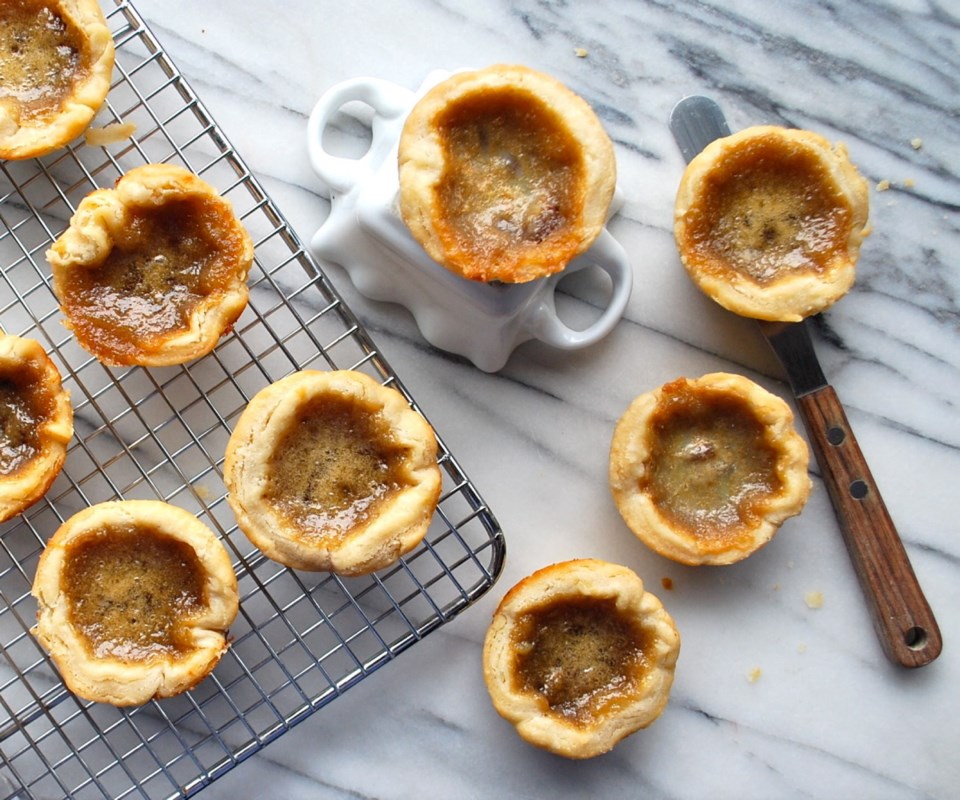This is third instalment in my series about the five classic Canadian desserts featured on a booklet of stamps released by Canada Post this year called Sweet Canada.
Four weeks ago, I wrote about blueberry grunt, a popular dessert in Atlantic Canada made by topping and cooking sweetened blueberries with tea-biscuit dumplings. Two weeks ago, I served up the popular-in-Quebec dessert tarte au sucre — sugar pie in English.
Today, my focus is butter tarts. Just saying those two words makes one think a rich and indulgent treat is what to expect when you bite into one and, when well made, that is very much the case. Filling and baking a flaky, small pastry shell with a mixture that generally consists of egg, syrup, sugar and, of course, butter, is how butter tarts are made.
The Canadian Encyclopedia (thecanadianencyclopedia.ca) says the first published recipe for them came in 1900 with The Women’s Auxiliary of the Royal Victoria Hospital Cookbook. That hospital is located in Barrie, Ont.
In the introduction to a recipe for them in the Complete Canadian Living Cookbook, they are called “the icon of Canadian cooking,” despite only being around for a bit more than a century. It also notes they probably originated with the popularization of corn syrup in Canada.
That is one theory I found on how they first came to be baked. But other sources suggest butter tart’s origins go much farther back in time and that they are likely an adapted version of similar sweets brought to Canada from France, such as the tarte au sucre I have already written about.
In an online article about butter tarts by the CBC, it says another theory suggests the butter tart is related to the pecan pie brought to Canada by American slaves. Yet another theory suggests they could be Scottish in origin, a place where a similar tart has long been made.
Because of these various theories on butter tarts’ origins, it’s not surprising that to this day there are still quite vigorous debates on how they should be made.
For example, some folks like the filling to be runny and gooey, others prefer is to be soft, but set. Some like to add dried fruit to the filling, such as raisins or currants, others think doing that is wrong because the original recipe did not call for them.
The filling for my butter tarts, when at room temperature, is mostly set, but still a little bit gooey and pleasing. I’m in the “lets-add-dried-fruit-camp,” so I put a few raisins in each tart.
Note: My next story in this series will be on Sept. 11. The topic will be Saskatoon berry pie.
Butter Tarts
I like serving these ultra-rich tarts, made with flaky pastry and a super sweet, buttery filling, with a fine cup of tea or coffee. A glass of cold milk also goes great with them.
Preparation time: 40 minutes
Cooking time: 17 to 18 minutes
Makes: 12 tarts
For the pastry
1 large egg
3 Tbsp ice-cold water
1 1/2 cups all-purpose flour
1/4 tsp salt
3/4 cup cold vegetable shortening, cut into small cubes
• vegetable oil spray
For the filling
1 large egg
1/2 cup golden corn syrup
1/2 cup golden brown sugar, packed
1 tsp pure vanilla extract
1/4 cup butter, melted
1/4 cup raisins
To make pastry, crack the egg for it into a small bowl. Add the water and beat until well combined.
Combine flour and salt in a mixing bowl. With a pastry cutter or two forks, or with the paddle attachment of your stand mixer, cut the shortening into the flour until well blended. Pour egg mixture into the bowl and mix until moist dough forms.
Transfer the dough to a lightly floured work surface. With lightly floured hands, shape the dough into a ball, and then press into a 1/2-inch thick disc. Wrap the disc of dough in plastic wrap and let rest in refrigerator 30 minutes.
Unwrap dough and return to the lightly floured surface. With a lightly floured rolling pin, roll dough into a 15-inch diameter, about 1/8-inch thick, circle. Now use a round cutter to cut the dough into 12, 4-inch rounds. You may need to gather up and roll out the scraps of dough to get all the rounds you need.
To doubly make sure the rounds of dough do not stick, lightly spray the inside of a non-stick, 12-cup muffin tin with vegetable oil spray. Now nestle a round of dough into each cup, creating a pastry shell for each tart.
Set the muffin tin in the refrigerator to firm up the dough while you make the filling.
To make filling, place the egg for it in a bowl and beat until the yolk and white are well blended. Add the corn syrup, brown sugar and vanilla and mix until well combined, but not frothy. Now slowly mix in the melted butter.
To make butter tarts, preheat oven to 375 F. When oven is preheated, divide and set some raisins into each pastry shell. Give the filling another stir, and then divide and pour it into the pastry shells, putting about 1 1/2 Tbsp of filling in each one. Bake butter tarts 17 to 18 minutes, or until the pastry is golden and filling is starting look set on the top.
Set the tin of butter tarts on a baking rack and cool 20 to 25 minutes. Now use a thin metal spatula to carefully loosen and lift the tarts out of the tin. Serve butter tarts warm, when the filling will be runny, or at room temperature, when it will be set and a little bit gooey.
Eric Akis is the author of eight cookbooks. His columns appear in the Life section Wednesday and Sunday.



